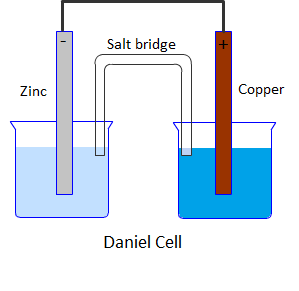
(a) Draw the labelled diagram of Daniel cell.
(b) Write the half-reactions of oxidation and reduction taking place on electrodes.
Answer
502.5k+ views
Hint: Recollect the difference between an electrolytic cell and galvanic cell. Where does oxidation take place in a galvanic cell? Think about the direction of electron flow in a galvanic cell.
Complete answer:
Galvanic cell is an electrochemical cell which converts chemical energy to electrical energy. Some examples include dry cell, fuel cell, Ni-Cd battery, lead storage cell.
Daniel cell is a galvanic cell in which a spontaneous chemical reaction takes place to produce electricity. It consists of two half cells. One half cell is a beaker containing a strip of metallic zinc dipped in 1M aqueous zinc sulphate solution. The second half cell consists of a beaker having a metallic strip of copper immersed in 1M aqueous copper sulphate solution. The two solutions are connected with the help of a salt bridge containing saturated solution of KCl in agar agar gel.
Daniel cell can be schematically represented as,
\[\left. Zn \right|\left. ZnS{{O}_{4}}(0.1M) \right\|\left. CuS{{O}_{4}}(0.1M) \right|Cu\]
Diagrammatically Daniel cell can be represented as:

Half-cell reactions:
-At Anode (Oxidation half-cell):
\[Zn(s)\to Z{{n}^{2+}}+2{{e}^{-}}\]
-At Cathode (Reduction half-cell):
\[C{{u}^{2+}}+2{{e}^{-}}\to Cu(s)\]
Note: Don’t get confused with charge on anode and cathode in electrolytic cell and galvanic cell. Remember LOAN-Left Oxidation Anode. In electrolytic cells, positively electrode is anode and negatively charged electrode is cathode. In galvanic cells, it is opposite. Positively charged electrode is a cathode and a negatively charged electrode is anode.
Complete answer:
Galvanic cell is an electrochemical cell which converts chemical energy to electrical energy. Some examples include dry cell, fuel cell, Ni-Cd battery, lead storage cell.
Daniel cell is a galvanic cell in which a spontaneous chemical reaction takes place to produce electricity. It consists of two half cells. One half cell is a beaker containing a strip of metallic zinc dipped in 1M aqueous zinc sulphate solution. The second half cell consists of a beaker having a metallic strip of copper immersed in 1M aqueous copper sulphate solution. The two solutions are connected with the help of a salt bridge containing saturated solution of KCl in agar agar gel.
Daniel cell can be schematically represented as,
\[\left. Zn \right|\left. ZnS{{O}_{4}}(0.1M) \right\|\left. CuS{{O}_{4}}(0.1M) \right|Cu\]
Diagrammatically Daniel cell can be represented as:

Half-cell reactions:
-At Anode (Oxidation half-cell):
\[Zn(s)\to Z{{n}^{2+}}+2{{e}^{-}}\]
-At Cathode (Reduction half-cell):
\[C{{u}^{2+}}+2{{e}^{-}}\to Cu(s)\]
Note: Don’t get confused with charge on anode and cathode in electrolytic cell and galvanic cell. Remember LOAN-Left Oxidation Anode. In electrolytic cells, positively electrode is anode and negatively charged electrode is cathode. In galvanic cells, it is opposite. Positively charged electrode is a cathode and a negatively charged electrode is anode.
Recently Updated Pages
Master Class 11 Social Science: Engaging Questions & Answers for Success

Master Class 11 Physics: Engaging Questions & Answers for Success

Master Class 11 Maths: Engaging Questions & Answers for Success

Master Class 11 Economics: Engaging Questions & Answers for Success

Master Class 11 Computer Science: Engaging Questions & Answers for Success

Master Class 11 Chemistry: Engaging Questions & Answers for Success

Trending doubts
What is meant by exothermic and endothermic reactions class 11 chemistry CBSE

10 examples of friction in our daily life

One Metric ton is equal to kg A 10000 B 1000 C 100 class 11 physics CBSE

1 Quintal is equal to a 110 kg b 10 kg c 100kg d 1000 class 11 physics CBSE

Difference Between Prokaryotic Cells and Eukaryotic Cells

Discuss the various forms of bacteria class 11 biology CBSE




